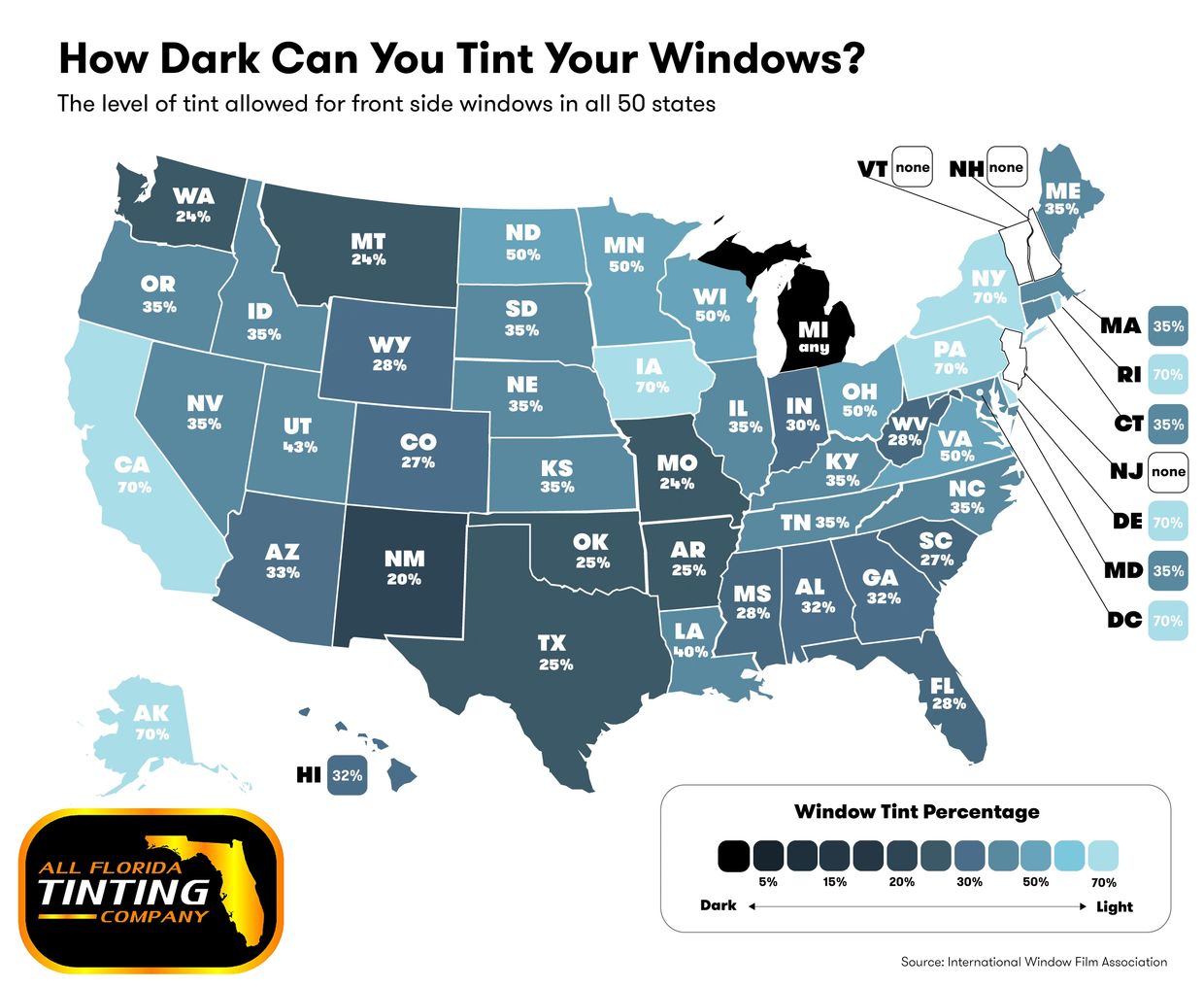Imagine you’re planning a cross-country road trip. You’re excited, but there’s one thing nagging at you: your car’s tinted windows.
Will you get pulled over in a new state? Navigating auto tint laws can be tricky because they vary from state to state. You might wonder if your car’s tint, which is perfectly legal at home, is acceptable elsewhere. This uncertainty can make you anxious and hesitant to hit the road.
You’ll discover how auto tint laws change across state lines and what you need to know to keep your journey smooth and worry-free. Stick around to learn how to avoid fines and enjoy your travels with peace of mind.

Credit: www.aptinting.com
Auto Tint Laws Overview
Understanding the nuances of auto tint laws can be tricky, especially when traveling across state lines. Each state has its own set of regulations, making it crucial for you to know what’s legal and what’s not. If you’ve ever wondered whether your car’s window tint is road-legal wherever you go, you’re not alone.
Purpose Of Tinting Regulations
Car window tinting offers multiple benefits like reducing glare, blocking UV rays, and increasing privacy. However, states enforce tinting laws primarily for safety reasons. Too much tint can obstruct visibility, increasing the risk of accidents, especially at night.
Imagine driving in a new state, only to be pulled over because your tint is too dark. It can be a real hassle, not to mention costly. Regulations aim to maintain a balance between your comfort and road safety for everyone.
Common Tinting Restrictions
Most states have specific rules on how dark or reflective your window tint can be. These are often measured by Visible Light Transmission (VLT) percentage. For example, a 70% VLT means 70% of light must pass through the glass.
- Windshield: Usually, only the top few inches can be tinted.
- Front side windows: Typically need to allow more light compared to rear windows.
- Back side and rear windows: Often have more lenient rules.
Have you ever noticed how police cars often have dark windows? That’s because law enforcement vehicles are typically exempt from these restrictions. But for your personal vehicle, sticking to legal limits can save you from fines and potential re-tinting costs.
Do you know the tint laws in your state, or do you rely on a professional to ensure compliance? Understanding these laws is not just about avoiding fines. It’s also about ensuring your own safety and that of others on the road.

Credit: www.reddit.com
State-specific Tinting Laws
State-Specific Tinting Laws can confuse many car owners. Auto tint laws differ across the United States. Each state sets its own rules on window tinting. This can create problems for drivers traveling between states.
Variability Across States
States have different rules for window tint darkness. Some states allow very dark tints, while others do not. The Visible Light Transmission (VLT) percentage varies. This percentage measures how much light passes through your car windows. A lower VLT means darker tint. Check state laws before tinting your car windows. Laws can also change over time. Staying informed about these changes is essential.
Examples Of State Regulations
California has strict tint laws. The front side windows must allow 70% of light. In Arizona, the rules are more relaxed. The front side windows need only 33% light transmission. Texas allows 25% light transmission for the front side windows. These examples show the diversity in state laws. Different states have unique requirements for tint reflectivity too. Some states ban certain colors of tint. Red and amber tints are often prohibited.
Federal Vs. State Regulations
Auto tint laws differ between federal and state regulations. Each state sets its own rules for window tinting. Moving to a new state might require adjustments to comply with local laws. Understanding these differences is essential for drivers.
Understanding the relationship between federal and state regulations on auto tint laws can be a bit like unraveling a tangled web. It might surprise you to learn that while there are federal guidelines, the real power lies with the states. Whether you’re driving across state lines or moving to a new state, knowing these differences can save you from legal headaches and fines.Role Of Federal Guidelines
Federal guidelines provide a broad framework for vehicle safety, including some aspects related to window tinting. However, their primary focus is on ensuring that vehicles meet safety standards for visibility and driver protection. The federal guidelines don’t dictate specific tint percentages, leaving much of the decision-making to individual states. These guidelines serve as a baseline, ensuring that no tinting obstructs visibility to a dangerous degree. Imagine driving in a fog—federal guidelines aim to prevent such scenarios caused by overly dark tints. But what about your state?State Autonomy In Tint Laws
States have the autonomy to establish their own specific auto tint laws. This means that what works for one state might not be legal in another. For instance, a tint that’s perfectly legal in sunny Arizona could get you ticketed in cloudy Washington. This autonomy allows states to consider local climate, safety concerns, and cultural factors when crafting their laws. It’s a bit like how some states allow right turns on red, while others don’t. Have you ever been caught off guard by a traffic rule when traveling? Before you hit the road, familiarize yourself with the tint laws of the states you’ll be driving through. A little research can prevent costly fines and keep your road trip stress-free. Remember, while federal guidelines are the skeleton, state laws are the flesh and blood of auto tint regulations. They shape the specific rules you need to follow, so staying informed is crucial.Impact On Drivers
Auto tint laws can be a real headache for drivers who frequently travel across state lines. As you zoom from one state to another, it’s crucial to remember that the tint on your windows might be perfectly legal in one state, but could land you in hot water in another. Being aware of these laws can save you from unwanted penalties and legal issues. Let’s break down how these regulations impact drivers.
Penalties For Non-compliance
If you find yourself driving through a state with stricter tint laws, you might face fines or even be required to remove the tint. Imagine cruising through a state only to be pulled over by a state trooper for something as simple as your window tint. It’s more than just a hassle; it can be costly.
States like New York and California have particularly stringent tint laws. You could face fines that increase with repeated offenses. This means that your once stylish tint could turn into a financial burden if you’re not careful.
Legal Implications For Travelers
For travelers, these laws can be a bit of a minefield. As you plan your road trip, do you consider the tint laws of each state you’ll pass through? You might not, but perhaps you should. These laws can vary widely, and ignorance won’t save you from penalties.
Consider this: a cross-country trip from Florida to Washington will take you through multiple states, each with its own set of rules. Some states might allow darker tints, while others limit how much sunlight your windows can block. It’s worth checking the regulations before you hit the road. Have you ever been caught off guard by state-specific laws?
Understanding the impact of auto tint laws on drivers can save you from surprises. Do you have any experiences with these regulations? How do you ensure compliance while traveling? Share your thoughts and join the conversation. Your insights might help fellow drivers navigate these tricky laws.
Staying Informed
Different states have unique auto tint laws that do not automatically carry over. Always check local regulations. Staying informed ensures compliance and avoids fines.
Staying informed about auto tint laws is crucial if you’re a driver who loves the sleek look and added privacy of tinted windows. Each state has its own set of rules, and these can change periodically. Moving across state lines or even planning a road trip could turn your perfectly legal tint into a potential fine. So how can you keep up with these varying laws?Resources For Tint Law Information
The first step to staying informed is knowing where to find reliable information. State Department of Motor Vehicles (DMV) websites are an excellent starting point. They usually have comprehensive details about the specific tint laws in your state. You can also check out online resources like the International Window Film Association (IWFA). They offer updated charts and guides on tint regulations across the U.S., making it easier for you to stay compliant. Don’t underestimate the power of local auto shops specializing in window tinting. These professionals often have the latest information and can offer practical advice based on your needs.Tips For Compliance Across States
If you’re planning to move or travel between states, consider the legal tint limits of each state you pass through. Some states are stricter than others, and it’s wise to know these differences in advance. Consider opting for a slightly lighter tint if you frequently travel across state lines. This can minimize the risk of non-compliance and keep you from drawing unwanted attention from law enforcement. Keep a copy of your tint certification in your car. This document can prove useful if you’re ever questioned about your vehicle’s window tint, especially if it meets the law in your home state. Knowing the rules and keeping your tint within legal limits can save you from headaches down the road. Are you ready to hit the road with confidence, knowing your tint won’t land you in hot water?
Credit: allfloridatinting.com
Frequently Asked Questions
Can You Get Pulled Over For Tint In Another State?
Yes, you can get pulled over for window tint in another state. Different states have varying tint laws. Ensure compliance with the specific state’s regulations to avoid fines. Always check local tint laws before driving across state lines to ensure your vehicle meets legal requirements.
Are Tint Laws The Same In Every State?
Tint laws vary by state. Each state sets its own regulations on window tint levels. Check local laws to ensure compliance. Penalties for violating tint laws differ across states. Always verify the tint percentage allowed in your state.
Will I Get Pulled Over For 20 Tint In Texas?
Texas law requires a minimum of 25% visible light transmission for front side windows. A 20% tint might lead to a traffic stop. Always ensure your window tint complies with Texas regulations to avoid fines or penalties.
How Do Cops Know If Your Tint Is Too Dark?
Police use tint meters to measure window tint darkness. Legal limits vary by state or country. If your tint appears suspiciously dark, officers may perform a visual check or use a meter. Ensuring your tint complies with local laws helps avoid fines and ensures safety.
Conclusion
Understanding auto tint laws is crucial for drivers. Laws vary state to state. Check local regulations before applying tint. This prevents fines and ensures safety. Each state enforces different rules. Your vehicle’s tint must comply with local laws. Being informed saves time and money.
Consult professionals for guidance. They help ensure your tint is legal. Stay updated on law changes. This helps maintain compliance. Remember, safety and legality matter most. Proper tint keeps your driving experience smooth. Follow state-specific guidelines for peace of mind.
Enjoy driving with confidence and clarity. Keep your vehicle legally tinted.
